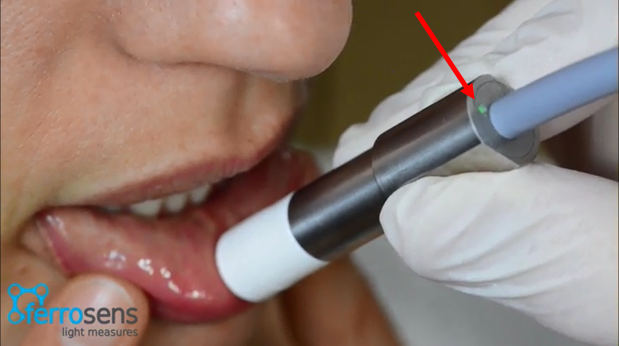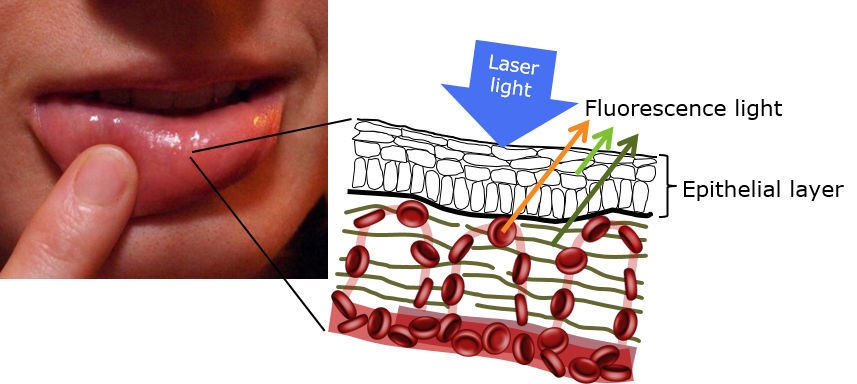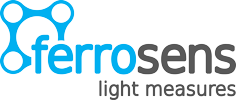We are happy to announce that our technology for the reliable detection of suitable measurement sites for non-invasive iron deficiency diagnosis has been granted as a patent in Europe. Equivalent applications in Asia and the US are pending, but with the decision of the European patent agency, we are very confident that granting there is only a matter of time.
In our measurement on the lower lip, the examiner is actively guided by a traffic light signal on the handpiece (see figure) to find the most suitable tissue site for a measurement. The selection of the most suitable tissue sites, as well as the notification of the user has now been secured in the patent.

In our embodiment, a green light signals that an optimal site has already been found. If the light signal is orange or red, the user has to move the applicator slightly over the lower lip to find a suitable spot. The application is so easy and intuitive that a short instruction is fully sufficient to ensure that even non-specialist examiners can determine the zinc protoporphyrin values of patients in a reliable and reproducible way.
Do you want to learn more about why our technology is needed for reliable iron deficiency measurements?
The measurement takes place on the inner side (the mucosa) of the lower lip. The following figure shows a schematic of its structure, with the epithelial layer on top and blood vessels in the underlying mucosal tissue.

There are several reasons why we measure on the lower lip: On the one hand, the mucosal tissue on the lip has only a very thin covering layer (nonkeratinized epithelial layer), and on the other hand, the tissue has high, densely packed blood vessels.
Another advantage is that the inner side of the lower lip is not pigmented, which means that in every ethnic group the inner side of the lower lip will always look rosy. Therefore there is no disturbing influence of pigmentation, and our measurement can be applied to people of every ethnicity.
Why is a thin epithelial layer, high-lying blood vessels and missing pigmentation important for our measurement?
Our iron deficiency measurement is based on the measurement of a very small fluorescence signal of the zinc protoporphyrin molecule (ZnPP), which is bound in the red blood cells (erythrocytes). The fluorescence is excited by blue laser light. For this purpose, the handpiece of our measuring device contains a glass fiber which transports the laser light to the lip and collects the generated fluorescence light.
Blue light is also very well absorbed by tissue, a thick epithelial layer could already attenuate the irradiated light to such an extent that fluorescence is no longer excited. At the same time, the fluorescent light produced is also absorbed and scattered by tissue structures. Here, too, a thick epithelial layer would attenuate the measurement signal strongly.
Blue light is perfectly suited for the excitation of ZnPP in erythrocytes, but at the same time a large amount of autofluorescence is generated in the surrounding tissue, which is many times (about factor 100) larger than our measurement signal. The following figure illustrates this very clearly in two graphs.

The left graph shows the fluorescence signal of ZnPP (green curve) and the corresponding background signal (black dashed line) in a blood sample. Here we do not expect any disturbing influences from surrounding tissue and therefore we get a very nice and clearly recognizable signal.
In the right graph a measurement at the lower lip is shown. Again in green our fluorescence signal of the ZnPP and in blue the background signal, which is about 100 times larger due to the excitation of surrounding tissue parts by the blue laser light.
This is where our patented FerroSens technology comes into the game: Our technology allows extracting the tiny ZnPP signal component, evaluates it quantitatively and finally indicates reliably whether a person is iron deficient or not.
Have you become curious about how our technology works, how our team is put together, what our future plans are, or want to get in touch with us?
Would you like to get an insight into our work or detailed information about iron deficiency?
Then simply request our white paper or pitch deck by filling out the linked forms.
Are you interested in our previous clinical studies and our scientific work on non-invasive iron deficiency diagnostics with laser light?
Have a look at our publications in peer-reviewed journals.



